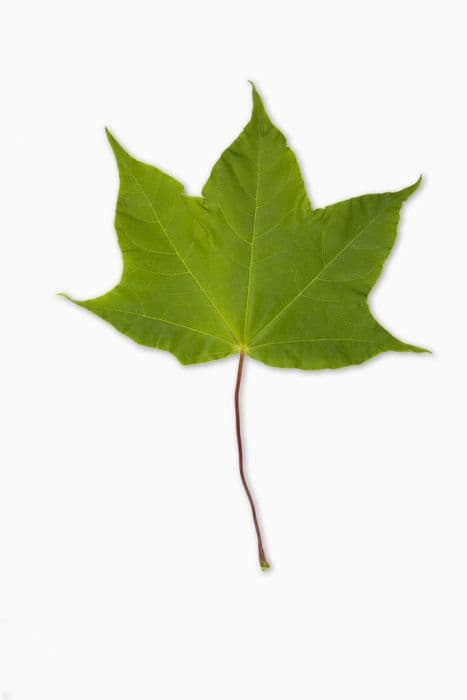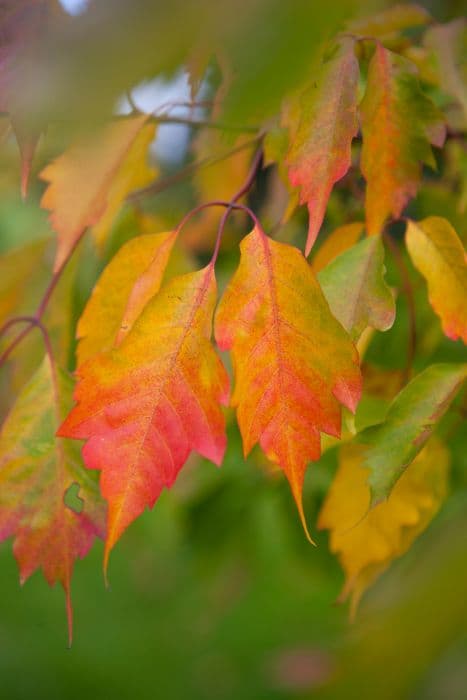Indian horse chestnut Aesculus indica 'Sydney Pearce'

ABOUT
The 'Sydney Pearce' is a selection of the Indian horse chestnut, known for its ornamental appeal. This variant of the deciduous tree is appreciated for its lush foliage, which unfurls a bright green in spring. The leaves are palmate, meaning they spread out like the palm of a hand with several leaflets (usually five to seven) emerging from a central point. Each leaflet is large, with a slightly serrated edge, giving the foliage a dense, full appearance. During the blooming period, the tree displays eye-catching flowers. The blossoms are arranged in erect, cone-shaped clusters called panicles, towering above the foliage and adding significant visual interest. These flowers are typically white with a hint of pink or yellow, sometimes spotted with darker colors. They are known to attract pollinators, such as bees, due to their attractive colors and nectar. The tree also produces fruit, which are spiny capsules containing one or more dark brown seeds that resemble conkers or chestnuts. The bark of the tree is another notable feature, with its smooth to slightly flaky texture when young, becoming rugged and furrowed with age. The Indian horse chestnut as a whole, including the 'Sydney Pearce', creates a picturesque silhouette with its spreading branches, making it a favorite in landscapes for visual appeal and shaded areas.
About this plant
 Names
NamesFamily
Sapindaceae.
Synonyms
Indian Horse Chestnut, Himalayan Chestnut.
Common names
Aesculus indica 'Sydney Pearce'.
 Toxicity
ToxicityTo humans
The Indian horse chestnut contains compounds that can be toxic if ingested by humans. Eating any part of the plant, including the seeds, leaves, or bark, can lead to symptoms of poisoning. These symptoms may include nausea, vomiting, diarrhea, abdominal pain, and muscle weakness. In severe cases, the neurotoxic effects can result in coordination difficulties, paralysis, or even respiratory failure if the toxin dosage is high enough.
To pets
The Indian horse chestnut is also toxic to pets. If pets ingest parts of the plant, such as seeds, leaves, or bark, they may exhibit symptoms of poisoning similar to those in humans. These can include vomiting, diarrhea, abdominal pain, depression of the central nervous system, and potentially, difficulty in walking or paralysis. Severe cases can be life-threatening, necessitating immediate veterinary attention.
 Characteristics
CharacteristicsLife cycle
Perennials
Foliage type
Deciduous
Color of leaves
Green
Flower color
Pink
Height
50 ft (15.24 m)
Spread
40 ft (12.19 m)
Plant type
Tree
Hardiness zones
7
Native area
Himalayas
Benefits
 General Benefits
General Benefits- Shade provider: The Indian Horse Chestnut (Aesculus indica 'Sydney Pearce') can grow to a large size, offering extensive shade in parks and large gardens.
- Aesthetic appeal: With its showy, white to pink flower panicles, this tree adds ornamental value to any landscape.
- Wildlife habitat: Provides food and shelter for various bird species and other wildlife.
- Urban tolerant: Capable of growing in urban environments where it can tolerate pollution to some extent.
- Seasonal interest: Offers spring blossoms, lush summer foliage, and interesting seed pods in the fall, contributing to year-round visual interest.
- Low maintenance: Once established, it requires minimal care, making it suitable for public spaces and low-maintenance gardens.
- Durable wood: The wood is hard and can be used for furniture and other woodworking projects.
- Erosion control: Helps prevent soil erosion with its extensive root system, especially on slopes and banks.
 Medical Properties
Medical PropertiesThis plant is not used for medical purposes.
 Air-purifying Qualities
Air-purifying QualitiesThis plant is not specifically known for air purifying qualities.
 Other Uses
Other Uses- The wood of the Indian horse chestnut is often used for making furniture and agricultural tools due to its workability and durability.
- In some regions, the timber is used in construction, particularly for making rough floors and boxes, since it is easy to split and work.
- The tree's large, broad leaves can be used in creating compost or as mulch for gardens, as they decompose and enrich the soil.
- Indian horse chestnut trees are often planted as ornamental trees in landscapes and parks for their showy, scented flowers and attractive foliage.
- The seeds, being quite hard and smooth, can be used in craft projects or as counters for board games.
- The bark has been traditionally used for tanning leather because of the tannins present in it.
- The Indian horse chestnut's presence can act as a natural erosion control due to its extensive root system that stabilizes the soil.
- Dried leaves and seed husks are sometimes used in creating natural dyes for fabrics, offering a range of brown hues.
- In rural areas, fallen branches can be gathered and used as fuelwood for fires and cooking, especially where other sources of fuel are scarce.
- The flowers of the tree may be used in the craft of making naturalised flower displays as they retain their shape and color well when dried.
Interesting Facts
 Feng Shui
Feng ShuiThe Indian Horse Chestnut is not used in Feng Shui practice.
 Zodiac Sign Compitability
Zodiac Sign CompitabilityThe Indian Horse Chestnut is not used in astrology practice.
 Plant Symbolism
Plant Symbolism- Strength: Aesculus indica, commonly known as the Indian Horse Chestnut, often symbolizes strength because of its robust trunk and the hardiness of the tree, withstanding various conditions.
- Endurance: These trees are known to endure through the changing seasons and can live for many years, symbolizing the ability to endure life's hardships and changes over time.
- Protection: With its broad and dense canopy, the Indian Horse Chestnut is seen as a protective presence, offering shade and shelter to those below, thus symbolizing protection and safety.
- Fertility: The prolific blooms of Aesculus indica 'Sydney Pearce' suggests fertility and abundance, often indicating new growth or the potential for new beginnings.
- Prosperity: The tree's association with fertility can also extend to symbolize prosperity, with the richness of its foliage often related to wealth and success.
 Water
WaterThe Indian Horse Chestnut requires consistent moisture but does not do well in sodden soil. In the growing season, water the plant deeply once a week with about 1.5-2 gallons, ensuring the soil is moist but not waterlogged. During hot, dry periods, increase watering frequency to twice a week. In winter, reduce watering to every other week, depending on rainfall and soil moisture. Always check the top inch of soil; if it's dry to the touch, it's time to water.
 Light
LightIndian Horse Chestnut thrives in full sun to partial shade. It's best situated in a location that receives morning sunlight and some afternoon shade, especially in hotter climates. Avoid deep shade, as insufficient light can hinder growth and bloom production.
 Temperature
TemperatureIndian Horse Chestnut grows best in temperatures ranging from 50°F to 77°F. It can withstand minimum winter temperatures down to about 20°F. Avoid planting in areas where temperatures consistently drop below this range, as it can damage or kill the tree.
 Pruning
PruningPrune the Indian Horse Chestnut in late winter or early spring before new growth begins to remove any dead, damaged, or diseased branches. Thinning out crowded branches every few years promotes better air circulation and light penetration, which is essential for the health of the tree. Annual light pruning helps maintain the desired shape and size.
 Cleaning
CleaningAs needed
 Soil
SoilThe Indian Horse Chestnut requires well-draining soil, rich in organic matter, with a pH ranging from 6.0 to 7.5. A mixture of loam, peat, and coarse sand is ideal for achieving appropriate drainage and fertility.
 Repotting
RepottingThe Indian Horse Chestnut should be repotted every 2 to 3 years, preferably in spring before the new growth starts, to refresh the soil and accommodate root growth.
 Humidity & Misting
Humidity & MistingThe Indian Horse Chestnut thrives in moderate to high humidity levels, typically around 40-60%, to mimic its natural montane habitat.
 Suitable locations
Suitable locationsIndoor
Ensure bright light, ample space, and monitor humidity for the Indian Horse Chestnut.
Outdoor
Place in partial shade with shelter from harsh elements for the Indian Horse Chestnut.
Hardiness zone
7-8 USDA
 Life cycle
Life cycleThe Indian Horse Chestnut 'Sydney Pearce' starts its life cycle as a seed, with germination occurring when conditions are warm and moist enough, usually in the spring. After sprouting, the seedling grows into a sapling, developing a sturdy trunk and branching out to form its characteristic broad, round canopy. As it matures, the plant enters the vegetative stage, where it grows in height and width, putting on more leaves and strengthening its root system. Upon reaching maturity, typically after several years, it begins the reproductive phase, producing spikes of white flowers tinged with pink or yellow, which can lead to the formation of its distinctive spiky fruit containing shiny brown seeds. The annual cycle of flowering and seed production continues throughout the tree's adult life, which can span several decades. In autumn, the leaves turn yellow or brown before falling, and the tree enters a dormant period during the cold months, conserving energy for the next growing season.
 Propogation
PropogationPropogation time
Spring to Summer
The Indian Horse Chestnut 'Sydney Pearce', a variety of Aesculus indica, is best propagated during its dormancy period, which typically falls in the winter season. One of the most popular and successful methods of propagation for this ornamental tree is through seed sowing. To propagate by seed, collect the seeds in autumn after they have matured and fallen to the ground. It is essential to stratify the seeds at cold temperatures between 34-41°F (1-5°C) for approximately 90-120 days to break their dormancy, a process that can occur naturally if they are sown outdoors in fall, as the winter cold provides the needed conditions. After stratification, the seeds can be planted in a well-draining soil mix at a depth of around 2 inches (5 centimeters). It's crucial to keep the soil consistently moist until germination occurs, which usually takes place in spring when the temperatures rise. Seedlings require care in their initial stages and can be transplanted to their permanent positions once they are sturdy enough.









